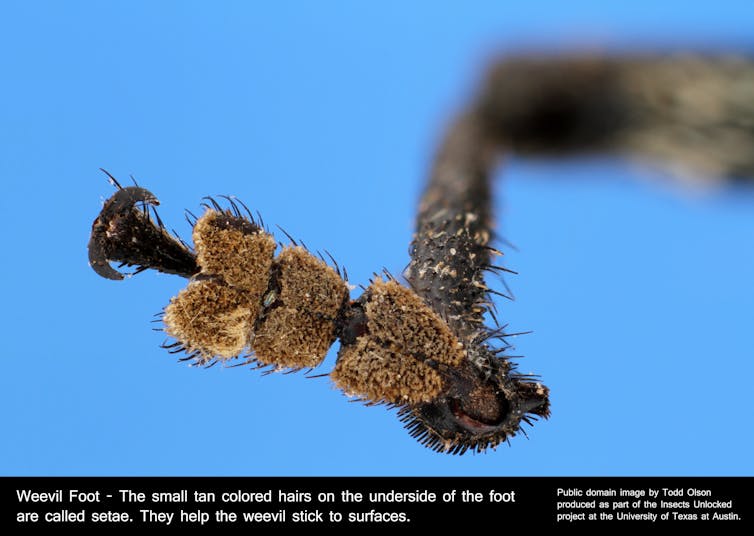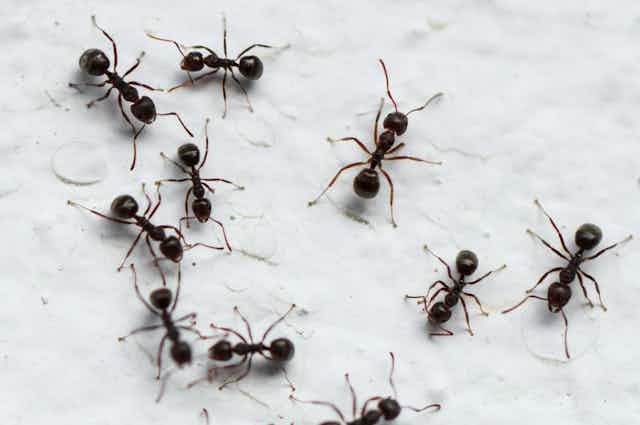Why doesn’t gravity bother ants and other creatures that can climb up walls or walk along ceilings? – Tsubamé, aged eight, London, UK
The reason most animals are not able to walk on the ceiling is due to a force called gravity. Gravity pulls everything down to the Earth. So, when you jump up, you are pulled back down.
This force will try to pull us down if we are dangling from something, so we need to have a strong hold if we are to hang from anything without falling off.
Now, although walls and ceilings look really smooth to us, they are in fact covered in lots of tiny holes and gaps. Small animals such as ants or spiders have very small feet, and they often have hundreds of thousands of hairs and bristles on their legs and feet.
These hairs and bristles can fit into the holes and gaps on walls. The ceilings are a bit like climbing walls for the insects – they can grab hold of lumps and bumps, using their many hairs, and stay put.
Hold on tight
There’s more to it than that, though. Insects attach to ceilings using something called a “van der Waals force”. This is when tiny molecules, such as those in the microscopic hairs on the end of insect’s feet, press really close to other molecules and stick together.

Curious Kids is a series by The Conversation that gives children the chance to have their questions about the world answered by experts. If you have a question you’d like an expert to answer, send it to curiouskids@theconversation.com and make sure you include the asker’s first name, age and town or city. We won’t be able to answer every question, but we’ll do our very best.
If we were to put our feet on a wall, there would always be small gaps between us and the wall, so we wouldn’t be able to stick. However, if a tiny insect, with even tinier feet, were to push its hairs against a wall, the molecules in the hairs can stick to the molecules on the wall.
The stickiness is weak, but with enough hairs sticking to the wall it is enough to keep the insects on the ceiling. As the sticking occurs because of a molecular force, this means that the insects can stick to a surface whether it is wet or dry, and they can even stick to very smooth surfaces such as glass.
Also, these animals are all very small and light. Lighter animals have a lower gravitational force acting on them to pull them off the ceiling. The stickiness of the van der Waals force is more powerful than the forces of gravity, so the insect sticks.

The hairs and bristles on insects’ feet increase the surface area, giving the insect a larger foot to stick to the ceiling. This makes insects really good at holding on.
Stuck like glue
Some insects are also able to produce a sticky substance, made from sugars and oils, from the end of each of their hairs. This acts a bit like glue, giving them even better sticking power to stay on walls and ceilings. In fact, if you look really closely where a fly has walked, you might see tiny, greasy footprints from the sticky glue.
Most insects also have claws at the end of their legs. Although these claws help them to hold on to things, the claws stop the insects from becoming stuck to surfaces forever. When the insect pushes down with its claw, it also twists it a bit to release the foot from the surface, allowing them to walk around.
It’s not just insects that can walk on walls and ceilings. Some reptiles and amphibians such as geckos and tree frogs can “stick” to ceilings. This is usually due to the same principles: huge toes to increase the sticking area, lots of small hairs and a secretion of gluey mucous.

